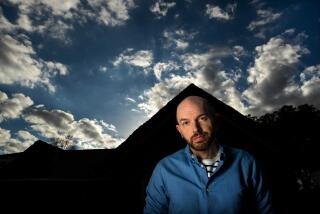Common Ground : Soviet, O.C. Teens Find They Share Same Problems
- Share via
COSTA MESA — Fifteen-year-old Joulia Grinkevitch, a student at Moscow High School in the Soviet capital, sat very still Tuesday as an American teen-ager spoke of how his mother beat him with a hanger and locked him in a closet. Joulia’s brow furrowed and tears welled as she listened to a girl say that all she wanted from her mother was love and attention.
Grinkevitch and her companions from the Soviet Union spent more than an hour at College Hospital in Costa Mesa Tuesday listening to troubled American teen-agers share their anger and sadness during a group counseling session.
Often, the visitors covered their faces to hide their emotions.
At the end, the foreigners became peers, hugging and comforting the American teens who had opened their hearts.
The six visitors, including one teen-ager from Italy, were almost at the end of a six-week journey that has taken them from New York to Washington, D.C., to Costa Mesa. They came to the United States at the invitation of an American doctor to learn how Americans counsel their youth. They hope to take home information to guide them in designing programs to help their teens with drug and alcohol problems.
Though problems of alcohol and drug abuse in the Soviet Union aren’t new, they have just recently been openly discussed. The Soviets, like Americans, want to teach their children how to eradicate the problems.
“Everywhere it is the same,” said Maya Ermolova, head of the largest drug-testing program in the Soviet Union. “The kids are everywhere the same.”
Ermolova said she is responsible for developing a drug and alcohol abuse education and prevention program in the Soviet Union and is especially interested in making peer counseling--teens helping each other--a major part of her plan. She said she brought teens with her so that she could get their viewpoint on youth problems and programs.
Since the spring of 1985 when President Mikhail Gorbachev acknowledged publicly that the Soviet Union has an alcohol problem, Soviet citizens have been trying to find ways to deal with it. Hospitals were soon treating the problem, and doctors stopped prescribing a shot of cognac to cure depression.
After a few years, treatment in the form of an Alcoholics Anonymous chapter began. The next move, Ermolova said, is to prevent abuse through education.
In addition to attending the afternoon counseling session, the group met with several American students from Fountain Valley who are involved in a drug prevention program in their high school.
“Our alcohol problem in Moscow and in the U.S.S.R. is one of the most severe ones,” Ermolova said. “And I should be honest telling you, that so far we don’t have a clear idea of how and in what way we can solve this serious problem.”
The Soviet high school students said they were ready to try the type of peer counseling programs that have been set up in schools throughout America.
Drugs in the Soviet Union are homemade, said Ermolova, who analyzes urine samples of people suspected of drug use or who are involved in car accidents. The most common types are marijuana, heroin, something similar to PCP and drugs prescribed by doctors, such as tranquilizers.
“The peculiarity of this problem creates the difficulties in solving it because it is not a matter of combatting some drug sellers. It’s a matter of having people understanding what they do is ruining themselves,” said Ermolova. “The most sad thing is that more than 80% of addicts and users are teen-agers. . . . Now we are seeking some social assistance.”
The drug of choice among Soviet teens is alcohol, the visiting students said. It is easy to get and a part of society. But none of the visitors could explain why their teens use addictive drugs.
“I must ask you this question,” Ermolova said. “Why are your teen-agers and your youth using drugs? Because before coming here, I thought that maybe some economical reasons of my country . . . is a purpose of using drugs for our teen-agers.
“But when I come to your country and I saw the prosperity of your country and the prosperity of all kinds of opportunities, now I start to think, ‘What’s the reason of using drugs?’ It should be something else.”
Several of the Soviet students said they were sure that some version of what they had seen and heard through their journey would work in their country and seemed eager to try.
“It is important to let (a drug user) know he is not alone, that all the world is not against him,” said Joulia, the 15-year-old from Moscow.
“There is no communication,” interrupted Maria Ledneva, a 19-year-old student who works with Ermolova. “There has to be communication. The parents will pay attention to political problems, and they don’t pay attention to their children.”
Lynne Bloomberg, a drug prevention specialist from Newport Beach who is housing one of the visiting students while in Orange County, said, “We find that our kids are all alike. They just speak different languages.”
More to Read
Sign up for Essential California
The most important California stories and recommendations in your inbox every morning.
You may occasionally receive promotional content from the Los Angeles Times.













